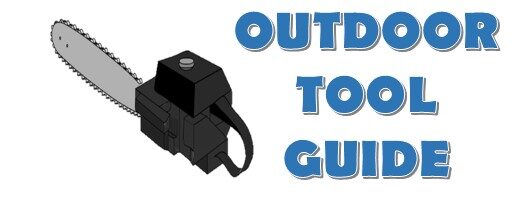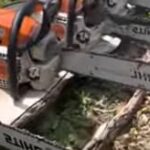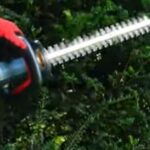As an Amazon Associate, this site earns commissions from qualifying purchases. For more information click here.
Hedge trimmer blades can and should be sharpened. Regularly sharpening your hedge trimmer blades is essential for efficiency, clean cuts and safety.
1.1 The Purpose of Hedge Trimmer Blades
Hedge trimmer blades are designed to cut through shrubs, hedges, and small branches. They function by moving back and forth rapidly, shearing plant material in a scissor-like action. A sharp blade makes clean cuts, which helps plants heal faster and reduces stress on the user and the motor. A dull blade, by contrast, tears and crushes plant tissue, leading to unhealthy hedges and an inefficient trimming experience.
Sharp blades save time. They also increase safety. When blades are sharp, they require less pressure to make cuts, reducing the risk of the trimmer slipping or binding.
1.2 Types of Hedge Trimmer Blades
Not all hedge trimmer blades are the same. Their construction and cutting edges vary, which affects how and whether they can be sharpened.
- Single-sided blades have teeth on one edge. They are safer for beginners and often easier to sharpen.
- Double-sided blades cut in both directions, making them faster but more complex to sharpen.
- Electric trimmers often have lighter, thinner blades with less aggressive teeth.
- Gas-powered trimmers are usually built for heavier-duty use, with thicker and stronger blades.
Understanding which type you own is the first step in determining the proper care and sharpening method.
1.3 What Dulls a Hedge Trimmer Blade?
Hedge trimmer blades do not stay sharp forever. Multiple factors contribute to blade dullness:
- Natural wear from repeated use grinds down the edge.
- Dirt and sap from plants build up on the blades and accelerate dulling.
- Impact with hard materials, such as fences, rocks, or wires, can chip or deform the blade edge.
- Lack of cleaning causes buildup that corrodes or rusts the blade.
- Storage in humid or unprotected conditions can also lead to oxidation and surface damage.
Even with the best intentions, blades will dull over time. Understanding the causes helps prevent premature wear.
1.4 How to Recognize a Dull Blade
It’s not always obvious when a blade has dulled. However, there are common signs:
- The trimmer no longer cuts cleanly. You may need to pass over the same area multiple times.
- Instead of slicing, the blade pulls or tears branches.
- The motor strains more than usual, overheating or slowing down.
- Vibration increases, and the tool becomes harder to control.
- The ends of cut branches look ragged or shredded.
These are strong indicators that the blade edge has worn down and may require sharpening or replacement.
After understanding how hedge trimmer blades work and why they become dull, the natural next question is: can they be sharpened? The answer is yes—most hedge trimmer blades can be sharpened. However, there are important details to consider. This chapter examines the blade’s structure, the tools required, and the pros and cons of doing it yourself versus hiring a professional.
2.1 Can Hedge Trimmer Blades Be Sharpened?
Yes, in most cases, hedge trimmer blades can be sharpened.
Sharpening restores the blade’s cutting edge, making trimming easier and more efficient. However, sharpening is only effective if the blade is not damaged beyond repair. If the blade is chipped, bent, or severely corroded, sharpening may not restore its full function, and replacement may be the better option.
Sharpening works best when done regularly, before the blade becomes excessively dull. A well-maintained blade will last longer and require less metal to be removed each time it is sharpened.
2.2 Blade Design and Its Role in Sharpening
Not all blades are created equal. The material and shape of a blade influence how easily it can be sharpened and how often it should be maintained.
- Material Composition: Most hedge trimmer blades are made of high-carbon steel or stainless steel. High-carbon steel holds an edge well and is easier to sharpen but is more prone to rust. Stainless steel resists corrosion but may take more effort to sharpen.
- Blade Coatings: Some modern blades come with protective coatings, such as Teflon or anti-stick layers. Sharpening these blades may remove or damage the coating, reducing rust resistance.
- Serrated vs. Straight Edges: Straight-edged blades are easier to sharpen because they have a consistent surface. Serrated blades require more care and may need special tools. Some serrated blades are not intended to be sharpened at all and are considered disposable.
- Tooth Shape and Spacing: Wide, open teeth are easier to access with sharpening tools. Close, narrow teeth may make sharpening more difficult or time-consuming.
It is important to identify the specific type of blade you have before choosing a sharpening method.
2.3 Tools Needed for Sharpening
Sharpening hedge trimmer blades does not require expensive equipment, but it does require the right tools and preparation.
- Flat File: A simple hand tool with a coarse surface, useful for sharpening straight-edged teeth. It allows for precision and control.
- Sharpening Stone: Good for fine-tuning the edge after filing. Also called a whetstone, it helps smooth out the roughness left by filing.
- Rotary Tool (such as a Dremel): For quicker sharpening, a rotary tool with a grinding bit can remove material faster. It requires a steady hand and protective eyewear.
- Bench Grinder: A powerful but less precise option. More suitable for experienced users or professionals sharpening heavily worn blades.
- Safety Gear: Sharpening involves metal filings and friction. Always wear protective gloves, safety glasses, and use a firm work surface.
Using the wrong tool or applying too much pressure can damage the blade. Patience and precision are more important than speed.
2.4 Manual vs. Professional Sharpening
There are two main ways to sharpen hedge trimmer blades: do it yourself or hire a professional.
Manual Sharpening (Do-It-Yourself)
Pros:
- Inexpensive
- Convenient—you can do it anytime
- A satisfying and educational process
Cons:
- Requires time and patience
- Mistakes can damage the blade
- Not ideal for blades with complex shapes
Manual sharpening is best for homeowners who are comfortable with basic tools and want to maintain their equipment regularly.
Professional Sharpening Services
Pros:
- Fast and accurate
- Handles complex or damaged blades
- Often includes cleaning and lubrication
Cons:
- Costs more than doing it yourself
- Inconvenient if the service is far away
- Not always worth it for low-cost trimmers
A professional service may be the right choice if you use your hedge trimmer often, or if the blade has been neglected for a long time.
Now that you understand the types of hedge trimmer blades and have learned that most can be sharpened, this chapter focuses on how to do it properly. It provides a complete walk-through—from preparing your workspace to post-sharpening care—and includes safety precautions and guidance on when sharpening is no longer the best option.
3.1 Step-by-Step Sharpening Process
Sharpening a hedge trimmer blade is not complicated, but it does require care and attention to detail. Below is a clear, step-by-step method for sharpening most standard blades.
Step 1: Disconnect Power and Remove the Blade (if necessary)
- Unplug electric trimmers or remove the battery. For gas-powered models, disconnect the spark plug.
- While some trimmers allow you to sharpen blades while attached, removing the blade makes the process easier and safer. Consult your owner’s manual for guidance.
Step 2: Clean the Blade Thoroughly
- Use a stiff brush or cloth to remove dirt, sap, and plant residue.
- Apply warm soapy water or a mild solvent if needed.
- Dry the blade completely to prevent rust during sharpening.
Step 3: Secure the Blade
- Clamp the blade to a stable workbench. The cutting edge should face upward and be easily accessible.
Step 4: Sharpen Each Tooth
- Use a flat file or sharpening stone.
- File in the direction of the original edge angle, usually about 45 degrees.
- Use smooth, even strokes—typically 5 to 10 per tooth, depending on how dull it is.
- Only sharpen the cutting edge. Do not file the flat underside of the blade.
Step 5: Check for Uniformity
- Make sure each tooth is sharpened to roughly the same length and angle.
- Uneven sharpening can throw the blade out of balance, causing vibration during operation.
Step 6: Reassemble and Test
- If you removed the blade, reattach it according to the manufacturer’s instructions.
- Reconnect the power source and briefly run the trimmer to test for smooth operation.
- Listen for unusual sounds and feel for excessive vibration.
3.2 Safety Precautions While Sharpening
Sharpening involves working with sharp metal edges, so safety must be a priority.
- Always disconnect power before working on the blade.
- Wear heavy gloves to protect your hands from cuts.
- Use safety glasses to shield your eyes from metal filings or debris.
- Sharpen in a well-lit, stable area to maintain control of your tools and work.
- Keep your tools in good condition—a damaged file or rotary tool can slip and cause injury.
Never rush the process. Take your time and remain focused on each movement.
3.3 Post-Sharpening Care and Blade Maintenance
A well-sharpened blade is only as good as the care it receives afterward. Regular maintenance extends the life of the blade and ensures better performance.
- Lubricate the Blade: Apply a light machine oil or spray lubricant after each use. This prevents rust and keeps the moving parts functioning smoothly.
- Wipe After Use: After trimming, clean off plant sap, moisture, and dirt. A quick wipe with an oily cloth helps protect the blade surface.
- Store in a Dry Place: Humidity causes rust. Store your trimmer indoors or in a dry shed. Use blade guards or covers when available.
- Inspect Regularly: Look for signs of wear, damage, or dullness. A visual check before each use can prevent problems later.
Routine maintenance reduces the frequency and effort needed to sharpen the blade again.
3.4 When to Replace Instead of Sharpen
No blade lasts forever. Eventually, sharpening will no longer be effective. Here’s how to know it is time to replace your hedge trimmer blade:
- Excessive Metal Loss: If a blade has been sharpened many times and the teeth have become noticeably shorter, it may no longer cut effectively.
- Cracks or Chips: Deep nicks, cracks, or missing teeth cannot be repaired by sharpening.
- Bent Blades: A warped blade may never cut straight, even if sharpened.
- Uneven Performance After Sharpening: If your trimmer still struggles after proper sharpening and maintenance, the blade may be beyond recovery.
Replacement blades are usually available from the manufacturer. In some cases, especially with low-cost models, replacing the entire trimmer may be more economical.

I love the outdoors and all the tools for maintaining gardens, yards and lawns. The only thing I am more passionate about is sharing what I know about garden and outdoor equipment.


